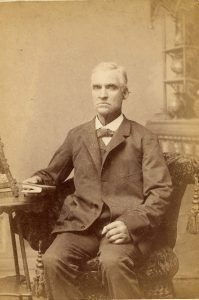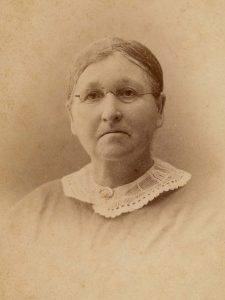
Many of us think of wagon trains when we think of people moving westward. However, when my Peelle family moved from Indiana to Kansas in 1879 the railroad had been completed all the way to their destination. And, locomotive power would take them to their new home.
The Decision To Move
Passco and Martha (Johnson) Peelle married in Wayne County, Indiana September 4, 1845. By 1878, their oldest 4 living daughters were married. Only William Johnson Peelle (William J.), their only son, and their two youngest daughters, Emaline D. “Lillie” and Mossie Lea, remained at home.
The family lived on 159 ½ acres near Lynn, Indiana in Randolph County, which is adjacent to Wayne County. For some unknown reason, that winter Passco and Martha decided to pull up roots, leaving their older daughters, who were married, behind.
Note: Their daughter Evaline and her husband John Farmer also moved to Kansas by 1880. However, they initially settled in western Kansas. By 1885, they had moved to Olathe, Kansas, where their youngest child was born. Later, Evaline and John moved to Bourbon County.

.
The Journey Begins
The first real indication that something might be afoot was November 13, 1878. On that date, William J. drove the hogs to Lynn, Indiana, which was a distance of three to four miles depending on his exact destination. He sold 19 hogs that evening. About a week later, he got a wagon from his brother-in-law Christopher Columbus “Chris” Longnecker and loaded it. The next day he took the load to Jay County, Indiana, for his father. On its own, it could have meant a load of corn or other commodity. However, the next day, he went back to Union City after stoves, which he took to Jay County.
Little, other than William J.’s typical activities, seemed to occur over the next month. Then, on December 28, he again went to Jay County. This time he stayed several days, returning home on New Year’s Eve.
In January, William J. made three trips to Jay County. On the last trip that month, he drove the cattle to Jay County and spent time at his father’s home. This is first statement that confirms that his father (and presumably his mother and younger sisters) had moved to Jay County. The question is, “Why?”
 Purchase The Property
Purchase The Property
William J. primarily spent the time he wasn’t going to Jay County, Winchester, Richmond, or the smaller towns nearby gathering, husking, loading, and transporting corn. On February 13, he declared that he had gathered the last of the corn. Still, more husking and transporting remained to be done.
On February 25, William J. husked more corn before leaving for Winchester that evening. The next day William J. did the paperwork necessary to purchase a 160-acre property near Hiattville, Bourbon County, Kansas from Frederick A. and Annie E. Engle. William J. signed for the property purchasing it for $1200 plus taxes owed. The sale took place in Randolph County because despite owning property in Kansas, the Engle family lived in Randolph County, Indiana. The transaction would not be recorded in Bourbon County for another month.
This raised several questions:
- Why Kansas? Why Hiattville?
- Why was William J.’s father (Passco) living in or recently living in Jay County?
- Was Passco already in Kansas? Martha? William J.’s younger sisters?
Location, Location, Location
No known relatives of Passco or Martha lived near Hiattville. If they did, that which would have also been a draw to move. However, James M. Hiatt, on whose land Hiattville was started lived in Randolph County, Indiana before moving westward. It is unclear if the family knew the Hiatt family. They likely did know some of the Engle family, but not necessarily the ones who owned the property they purchased, as some of them owned property nearby.

Jay County
Moving his family to Jay County made me wonder if they initially planned to move to Jay County permanently and something changed their mind. However, I suspect that wasn’t the case as early on William J. sold the hogs. If it was a matter of a few miles, it seems they would have simply moved the hogs to Jay County.
I also wondered about access to roads or trains, but found no significant difference between the two counties. I haven’t yet had an opportunity to do local research to see if they owned property in Jay County or rented.
Where Was Everyone?

The answer to this question is unknown. However, if Passco was still in Jay County, why wouldn’t he have come to Winchester to purchase the property instead of sending his 23-year-old son to transact the business. William J. did transfer the property to his father, but not for several years.
It is possible that Passco’s brother John Cox Peelle, who lived in Winchester, provided William J. some support, but why wouldn’t Passco have made the short trip to Winchester? My guess is that Passco, at least, was already in Kansas, having gone there to check out the property.
Car The Goods
On March 1, William J. went to Portland, which was in Jay County and which was the main railroad center in the county. Then on March 10, William J. said that he moved to Jay County. Now, this statement is curious as he spent the remainder of the time before he moved to Kansas primarily in Randolph County. It seems, however, that he may have moved the remainder of the household goods to Jay County.
Then on March 15, 1879, William J. “boxed up things to ship to Kansas.” He finished the task the next day and began loading them on a wagon. The following day, he finished loading up the wagon. At that point, the house must have been bare as he spent the night at someone else’s house. Then on Tuesday March 18, he hauled them to Union to car them, which meant to get them loaded on a railroad car. He had to wait until Thursday for a car to be available. After they were loaded, he headed to Winchester.
Here, There, And Everywhere
After all the farm tasks were complete and the goods were shipped to Kansas, William J. spent time with various friends and relatives in the area. He always liked to go places – lectures, classes, events, or simply visiting. Everywhere he went he was helping with farming or carpentry, which would be his two primary focus areas throughout his life.
Probably the most interesting of his travels was when he went to the big city of Richmond. On April 11, he went via buggy to Richmond and spent the night at Uncle Will’s. Uncle Will would be his father’s brother William Adams Peelle, who was a lawyer, judge, and had held several state offices. I wish I knew if this was just a visit or business. I suspect the latter as he returned to Richmond on April 24.
Sometimes he traveled with his trunk and sometimes he traveled around and later went to get his trunk and take it to another relative’s house.
Then on May 18, William J. sold his horse. Now, he had to walk or rely on others to get around. But, he didn’t let that stop him. He walked from where he sold his horse to Winchester. He stayed with his Uncle John. The next day he hopped on the train to his typical stomping grounds. From there he continued his travels around the area.

Kansas Bound
Last Good-Byes
When June arrived, the time for William J. to move westward arrived. He spent the first three days of the month with three of his sisters’ families . . . or as he would say with Wiley Benson (Rachel), Chris Longnecker (Sarah), and Bill Lewis (Jennie).
On June 4, Chris Longnecker took William J. and William J’s trunk to his Uncle John Peelle’s home in Winchester. The next day he took the morning train to Farmland. He spent the night at Sam Bolinger’s, assumed to be a friend, and returned to Winchester the next evening. On June 7 he made a trip to Bloomingsport, one of the places close to the Peelle Indiana home that William J. visited frequently. He stayed with John Benson (his brother-in-law’s brother) and the next day, after another visit to Bloomingsport, John took William J. to Winchester to catch the train for Hiattville, Kansas.
The Trip
William J. left Winchester at 8:40 p.m. headed to Muncie, Indiana. He spent the night there and left the following morning at 6:10 a.m. From there he traveled to Bloomington, Illinois where he had a four-house layover. He left Bloomington at 6:10 p.m. His next destination was Kansas City. He arrived there the following morning at 9:30 a.m. At 11:00 a.m., his travel turned southward. He had dinner at Lacygne and arrived in Ft. Scott at 4:30 p.m.
That night William J. splurged and spent $1.25 to stay at the Lockwood House. It was located only a block from the MK&T (Missouri, Kansas & Texas) Railroad Station (also known as the “Katy”) on Jones Street. Jones Street is better known by its current name of “National Avenue.” It was at the edge of the flood zone for the Marmaton River as the “big flood” the year prior had reached to the hotel.
The next morning (June 11) William J. left Ft. Scott at 4:35 a.m., arriving at Hiattville, his final train stop, at 6:00 a.m. From there he went to “his father’s house,” which was an interesting reference since it was William J.’s name that was on the official paperwork for the property.
He came back to Hiattville to get his trunk, but did not get it. He had to come back in the afternoon to get it. So, it seems that luggage issues existed even back in 1879!
Afterward – Why Move?
The question remains: “Why did the family decide to move?” Several reasons for the move can be eliminated. They didn’t move to get more land as the land they purchased was approximately the same size as the property they left behind. For the same reason and the fact that they paid to move via train, one can surmise that they didn’t move because they were in financial trouble.
One other story that my aunts told was that they thought the family moved because William J. got a woman pregnant and he needed to leave the area. If that was the reason, one would think William J. would have been the first one in the family to leave the area. However, it appears that he was the one that stayed behind. And, he made trips back to Indiana after he made the move. Thus, I believe this story is debunked.
Unless a letter or an article is found, we will likely never know why they moved.
Featured Image: Public Domain, retrieved July 9, 2024 from Wikipedia.
 Purchase The Property
Purchase The Property